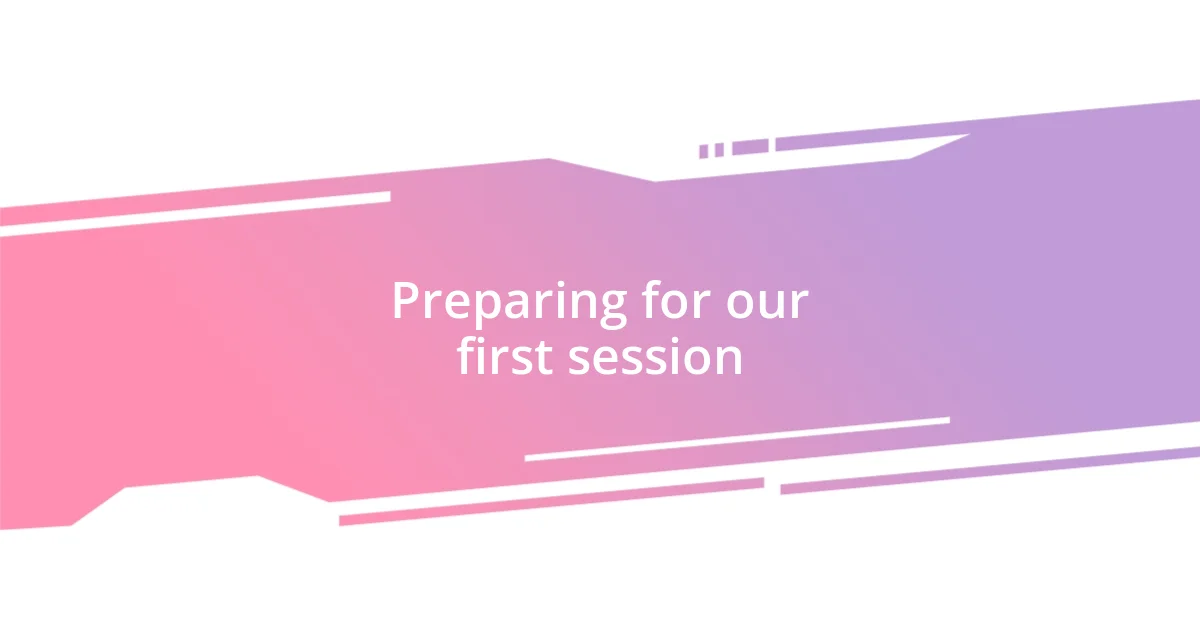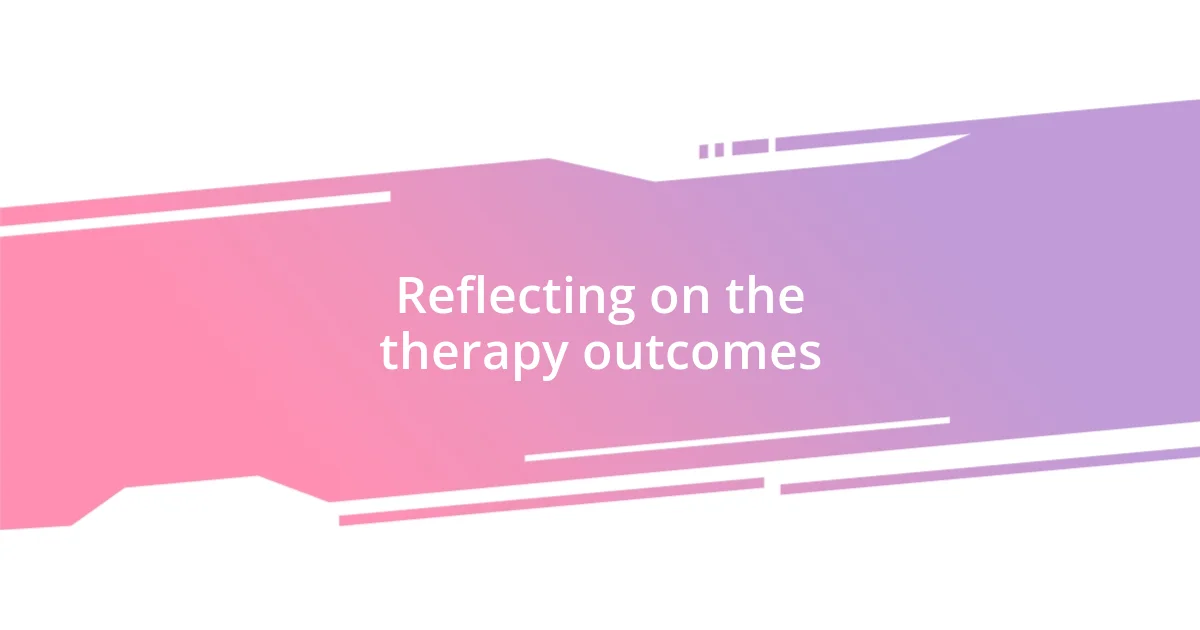Key takeaways:
- Family therapy began as a leap into the unknown but evolved into a pivotal experience, fostering vulnerability and openness among family members.
- Choosing the right therapist is crucial, focusing on expertise, approach, comfort, availability, and reputation to ensure a good fit for the family dynamics.
- Setting realistic goals in therapy promotes inclusivity and connection, encouraging honest dialogue and gradual progress towards resolving deeper family issues.

My journey into family therapy
I remember the day we first stepped into the therapist’s office. The tension in the car was palpable, each family member lost in their thoughts, contemplating how this experience might unfold. It felt like a leap into the unknown, which made my heart race—could our family really navigate the complexities we had been avoiding?
As we settled into that cozy, slightly worn room, I noticed the therapist’s warm smile bringing a sense of calm. I couldn’t help but wonder, was this the moment we’d find a way to communicate without barriers? I was taken aback by how quickly we began to open up; it was as if the walls we’d built were starting to crack around us, unveiling vulnerabilities we had long buried.
Reflecting on my journey, I realize that family therapy was more than just a space for dialogue; it became a pivotal turning point. There were moments of raw emotion, shouting and tears flowing, yet inside me grew a flicker of hope. I often ask myself, could we have achieved this breakthrough without that brave first step into therapy? Each session peeled back layers we didn’t even know existed, revealing the heart of our family dynamics.

Understanding family therapy basics
Family therapy is essentially a collaborative process involving family members and a trained therapist. I remember sitting down for our first session, the therapist explaining that the goal was to facilitate communication and improve relationships. This highlighted one of the central tenets of family therapy—understanding dynamics and patterns that often go unnoticed.
What’s fascinating is that family therapy comes in various forms, each with its unique approach. For example, some therapists focus on systemic therapy, analyzing interactions as a whole, while others might employ narrative therapy, encouraging family members to share their stories. These methodologies can make a significant difference in how we perceive our roles and contribute to family harmony.
Looking back, I found that recognizing each person’s individual experiences and feelings was crucial in our sessions. It’s incredible how, once we started acknowledging each other’s perspectives, it became easier to tackle long-standing issues. In those moments, I learned that empathy and understanding are at the core of meaningful family therapy.
| Types of Therapy | Description |
|---|---|
| Systemic Therapy | Focuses on family interactions and dynamics as a whole. |
| Narrative Therapy | Encourages storytelling to understand personal and family narratives. |
| Behavioral Therapy | Addresses specific behaviors and patterns to foster positive change. |
| Emotionally Focused Therapy | Emphasizes the emotional bond between family members. |

Choosing the right therapist
Choosing the right therapist is a critical step in the family therapy journey. I remember how daunting it felt to sift through endless options. Ultimately, I learned that finding a therapist who not only specializes in family dynamics but also resonates with our family’s unique culture was essential. It’s like searching for the perfect puzzle piece; the right fit makes all the difference.
Here are some key factors to consider when choosing a therapist:
- Expertise: Look for a therapist who specializes in family therapy and understands the dynamics at play.
- Approach: Different therapists use varied techniques; sharing your preferences can guide you toward someone whose style aligns with your needs.
- Comfort: Ensure that you feel comfortable with the therapist; an open mind and heart can lead to profound breakthroughs.
- Availability: Check their scheduling and ensure it accommodates your family’s busy life.
- Reputation: Read reviews or ask for recommendations. Hearing others’ experiences can provide valuable insights.
Finding the right therapist isn’t just a checkbox; it can alter the trajectory of your family’s healing process. In my case, we finally connected with someone who understood our quirks and could navigate our complexities with genuine empathy. That initial spark of trust deeply influenced our sessions, allowing us to tackle our challenges more openly.

Preparing for our first session
Preparing for our first family therapy session felt a bit overwhelming. I clearly remember jotting down my thoughts and feelings before we even stepped foot in the therapist’s office. It wasn’t just about what I wanted to say; it was about capturing the essence of what I felt we needed to address. Isn’t it often the case that articulating our concerns in writing makes them feel more tangible and manageable?
As our session day approached, we had honest conversations about what we hoped to achieve. My family and I sat around the table, each of us expressing our fears and expectations. It was eye-opening to see how everyone had different perspectives on our issues. This shared dialogue created a sense of unity, allowing us to enter therapy with a clearer purpose. Have you ever thought about how simply discussing your goals with your family can lighten the emotional load?
On the day of the session, I felt a mix of excitement and anxiety. Walking into the therapist’s office, I realized how crucial it was for us to set the right atmosphere. My heart raced, but as we settled in, I took a deep breath and leaned into the experience. Remember, it’s okay to feel vulnerable; it’s a sign that you’re opening yourself up to growth and healing. Embracing that vulnerability allowed us to fully engage with the process ahead.

Navigating emotional challenges
Navigating emotional challenges during family therapy can feel like an emotional rollercoaster. I recall moments when raw feelings bubbled to the surface, making it tough to articulate my thoughts without getting overwhelmed. Have you ever found yourself so wrapped up in an emotion that you struggled to find the right words? I remember times when simply taking a breath or sharing a pause with my family helped us shift from reacting to reflecting. These moments of silence were surprisingly powerful, allowing us to reset and approach our discussions with more clarity.
As we dove deeper into sensitive topics, I found it crucial to create a safe space for everyone to share their emotions. There were times when I felt a knot in my stomach, worried about how my words might be received. Yet, I learned that these uncomfortable feelings are often indicators of important conversations. I encouraged my family to share their fears openly, fostering a culture of honesty. Eventually, this transparency cultivated a deeper trust, allowing us to embrace our vulnerability together. Have you considered how opening up about your own fears can inspire others to do the same?
I also began to recognize patterns in how we communicated. During one session, emotions ran high, and it became apparent that certain phrases triggered defensiveness. It was a wake-up call for me—self-awareness in the moment was key. I made a conscious effort to replace accusatory language with more “I” statements, like “I feel hurt when…” Instead of pointing fingers, I focused on sharing my perspective. This subtle shift transformed our discussions, helping us understand each other better. Navigating these emotional minefields takes practice, but trust me, the growth that comes from it is worth every effort.

Setting realistic goals
Setting realistic goals became a pivotal moment for my family during therapy. In one of our early sessions, we collectively discussed what we wanted to achieve. I remember thinking, “What’s the point in aiming for the stars if we can’t even agree on a single step forward?” This prompted us to reassess our aspirations. Instead of diving straight into resolving deep-seated issues, we focused on smaller, achievable targets like improving communication or spending more quality time together. By keeping our goals grounded, we created a sense of accomplishment that slowly built our confidence.
As I reflected on these goals, I realized how crucial it was to ensure everyone’s voice was heard in the process. One evening, after a particularly enlightening session, we gathered as a family to share what success looked like for each of us. This not only fostered inclusivity but also highlighted the emotional stakes involved. Seeing my sister express her desire for more open dialogue, I thought, “Sometimes, what seems like a simple wish is rooted in a much deeper need.” By validating each other’s aspirations, we created an environment where everyone felt invested in the journey.
I discovered that goal-setting is not just about listing what we hope to achieve; it’s about understanding why those goals matter to us. I vividly recall a therapeutic exercise where we wrote down our top three priorities. It struck me how different our individual answers were, yet they all pointed to a common theme: a longing for connection. Have you ever found that what you truly seek is often hidden beneath the surface? By regularly revisiting these goals, we were able to adjust our approach as needed, keeping our family dynamic on an uplifting path rather than striving for perfection.

Reflecting on the therapy outcomes
Reflecting on the outcomes of family therapy led to profound realizations for me. One particularly impactful moment occurred when my therapist invited us to share what we had learned about ourselves and each other. I remember listening to my parents articulate their own struggles, which opened my eyes to their vulnerabilities. It was a reminder that we all carry our burdens—have you ever felt a weight lift just by understanding someone else’s story? This newfound empathy changed how I approached conflicts, fostering a deeper sense of unity within our family.
As we navigated therapy, I often found myself jotting down insights in a journal. One day, I stumbled upon a passage where I expressed gratitude for the time spent in sessions. Reflecting on that feeling, I realized therapy offered not just emotional healing but a chance to celebrate our small victories. Watching my brother blossom into a more open communicator reignited my hope. It sparked a sense of joy in me that I hadn’t anticipated, almost like witnessing a garden bloom after a long winter. How do you celebrate progress in your life? For me, recognizing these moments was essential.
Over time, the therapy’s impact extended beyond our sessions. I noticed that the simple act of checking in with each other became a routine that enriched our family bonds. One afternoon, while cooking dinner together, we began discussing our feelings about daily stressors, a topic we used to avoid. The laughter and support flowing around the kitchen felt like a gentle reminder of our resilience. These outcomes taught me that therapy doesn’t just end with the final session; it’s about integrating growth into everyday life. Wouldn’t you agree that those little shifts often lead to the most significant changes?














